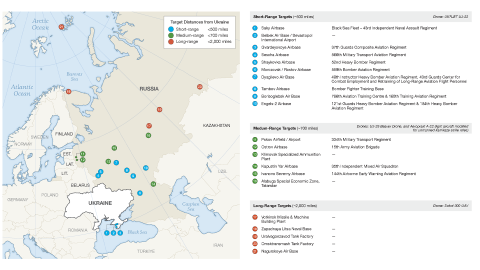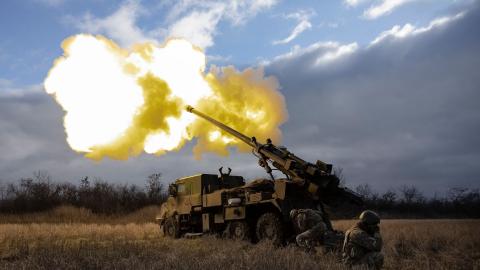Below Hudson Senior Fellow Can Kasapoğlu offers a military situation report about the war in Ukraine.
Executive Summary
- Delays in Western aid have put Ukrainian lines at risk of collapse.
- French CAESAR self-propelled howitzers have helped Ukrainian artillery units overcome their quantitative disadvantage.
- Ukraine has lowered its mobilization age from 27 to 25, suggesting a severe manpower shortage.
- Ukraine’s innovative deep-strike capabilities like the A-22 Foxbat continue to target critical Russian assets.
1. Battlefield Assessment
As Ukraine awaits new military equipment and ammunition from its Western partners, the country’s lines of defense are becoming increasingly fragile. Ukrainian forces face the risk of collapse, especially in the east.
Several high-level military officials who served under the previous commander in chief of the Ukrainian Armed Forces, Valeri Zaluzhnyi, have argued that Ukraine’s defensive lines are weak and vulnerable. These officials fear that Russia could penetrate Ukrainian fortifications. Over the past week, Russia reportedly capitalized on this critical vulnerability, scaling up the frequency, tempo, and intensity of its mechanized ground assaults along multiple axes. Continued success in these efforts would pose a broad strategic threat to Kyiv.
The United Kingdom’s Defense Intelligence indicates that Russian formations are entrenching their gains in Avdiivka and amassing more combat formations there for a deeper push. According to reports from late March, the Russian military has maintained a steady advance to the west of the occupied city, allegedly capturing several nearby villages.
At several other flashpoints, including Kupiansk, Spirne, and Bakhmut, positional fighting continued this week, demonstrating each side’s focus on counter-battery fire. Russia’s artillery advantage forces the Ukrainians to take greater measures to protect their batteries. The French CAESAR self-propelled howitzer has helped them do so.
One of the world’s lightest 155mm self-propelled guns, the CAESAR has enabled Ukrainian forces to employ “shoot-and-scoot” tactics—moving the weapon system after each use to avoid Russian counter-battery fire. So far, Ukraine has reportedly lost only 10 percent of its CAESAR howitzers. This compares favorably to the 30 percent rate for other self-propelled or towed systems.
Kyiv also continued its strikes on Russia’s strategic military facilities. On April 4, Ukraine attacked the Morozovsk air base, located 186 miles inside Russia. Available evidence suggests that a series of explosions shook the base, which hosts a large number of Russian Su-34 fighter-bomber and Su-24 frontline bomber aircraft. Kyiv’s strike package included a drone swarm of over 40 Ukrainian loitering munitions, which overwhelmed Russian defenses in the area. Several outlets claimed that the attack also targeted other critical air bases, including Yeysk and Engels—the latter of which hosts strategic bombers.
2. With Summer Nearing, Ukraine Gears Up for Expanded Mobilization
Anticipating a Russian offensive in summer 2024, Ukraine is reducing the age of mobilization from 27 to 25 in an effort to increase manpower. Though the timing and the nature of the legislation reflect Ukraine’s pressing need for fighters, President Volodymyr Zelenskyy has yet to approve an even more expansive mobilization law.
Military intelligence estimates suggest that the Russian military invaded Ukraine in 2023 in a disorganized fashion with only 360,000 troops. In summer 2023, when Ukraine began its offensive, the Kremlin increased its forces to 410,000 soldiers and improved its organization on a defensive footing. The success of Russian engineering units in building some 1,300 miles of layered defenses aided Moscow’s efforts, and by the beginning of 2024, the number of Russian troops on Ukrainian soil had risen to 470,000.
Currently replenishing its forces at a rate of 30,000 troops per month, Moscow holds an advantage over Kyiv in both its force-on-force ratio and its force-to-terrain ratio. These numbers match reports by the deputy chief of Ukraine’s Main Intelligence Directorate, General Vadym Skibitsky, who has suggested that Russia can mobilize between 1,000 and 1,100 recruits per day.
Kyiv’s new legislation attempts to close the manpower gap by boosting the Ukrainian Armed Forces’ depleted ranks. It also signals an effort to adapt Ukraine’s military strategy to sustain a multifront war in a protracted conflict.
But a larger military requires more funding. Decreasing the age of mobilization, therefore, could place a burden on Ukraine that amounts to several billion dollars. It remains to be seen whether Kyiv can allocate sufficient resources to sustain its soon-to-be-expanded forces.
3. Ukraine’s Defense Technological and Industrial Base (DTIB) Develops New Indigenous Solutions
Map 1: Ukraine’s Drone Warfare / Deep-Strike Capabilities and Its Potential Target Set inside Russia and Occupied Crimea

Despite Ukraine’s manpower struggles, Kyiv’s burgeoning defense technological and industrial base is advancing several promising initiatives.
Its kamikaze drones, with increased range, have the potential to slowly bleed Russian forces. Open-source intelligence indicators suggest that since last year, the operational range of Ukraine’s loitering munitions and kamikaze aircraft has increased significantly, enabling Kyiv to target strategic military assets such as drone and missile production plants deep within Russia.
As Ukrainian sources have reported, Kyiv is rapidly expanding its arsenal of innovative deep-strike assets. One such asset is the Sokol-300, a drone with a 600-pound payload and a range of 2,000 miles that puts most of Russia’s major airbases at risk, including those on the Kola Peninsula. Notably, the design philosophy behind the Sokol-300 has more in common with medium-altitude long-endurance (MALE) drones than with traditional loitering munitions. A highly destructive long-endurance platform, the Sokol-300 can strike as many as 80 Russian bases, including those that host critical assets like long-range bombers.
Another deep-strike asset making headlines for Kyiv is the Aeroprakt A-22 Foxbat. This indigenous aircraft, which can be manned or unmanned, struck the joint Russia-Iran drone production plant in Tatarstan last week. Evidence suggests that the A-22 is an inexpensive, single-propeller sport plane. It costs less than $100,000 and comes fitted with a wide range of autonomous controls. The system is scalable and affordable and—most importantly for Kyiv—possesses deep-strike capabilities.
















